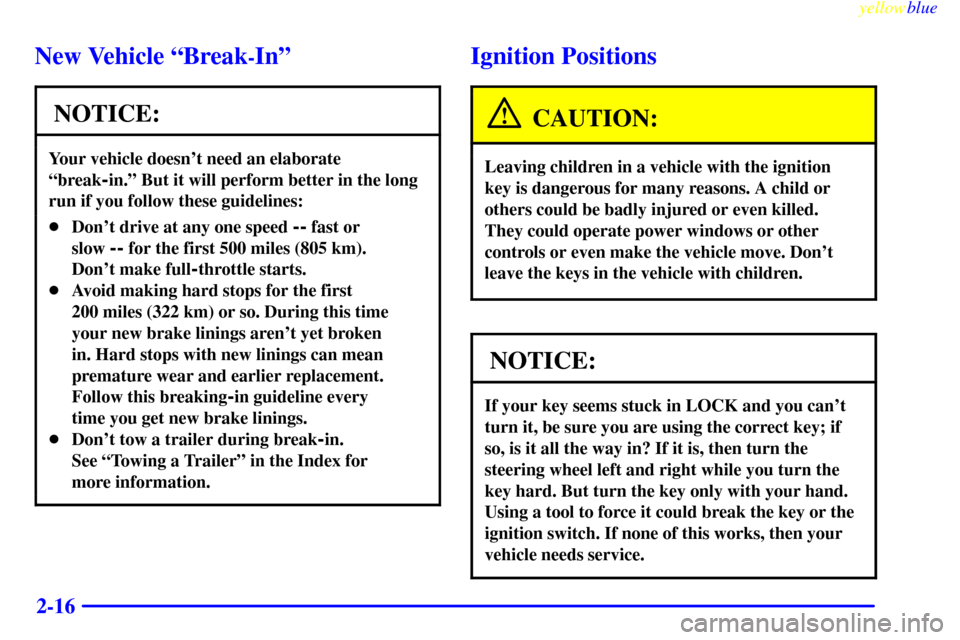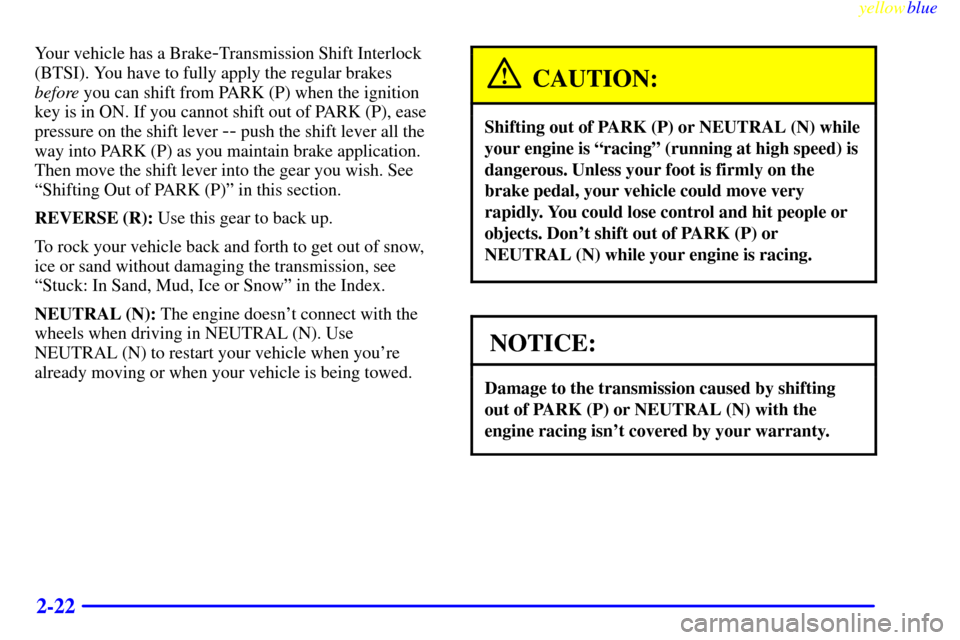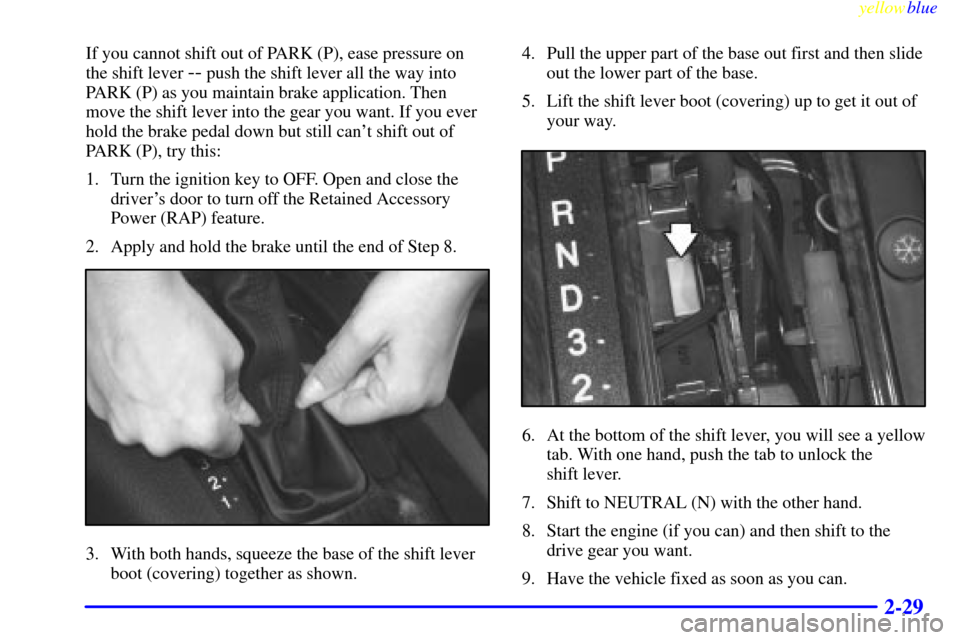Page 77 of 328

yellowblue
2-15
Immobilizer
Your vehicle is equipped
with a passive
theft
-deterrent system.
This device complies with Part 15 of the FCC Rules.
Operation is subject to the following two conditions:
(1) this device may not cause harmful interference,
and (2) this device must accept any interference
received, including interference that may cause
undesired operation.
This device complies with RSS
-210 of Industry Canada.
Operation is subject to the following two conditions:
(1) this device may not cause interference, and (2) this
device must accept any interference received, including
interference that may cause undesired operation of
the device.Changes or modifications to this system by other than an
authorized service facility could void authorization to
use this equipment.
The system works when you turn the key to ON (II). The key
uses a transponder that matches an immobilizer control unit
in your vehicle. The correct key will start the vehicle.
When the system senses that someone is using the wrong
key, it may start but it will not continue to run. If someone
tries to start your vehicle again or uses another key during
this time, the shutdown will start over again. This
discourages someone from randomly trying different keys
with different transponders in an attempt to make a match.
If the engine cannot be started, turn the key in the
ignition to ON (II). Wait approximately two seconds;
then start your vehicle again.
If the engine still won't start, try another key. You may
also want to check the fuses (see ªFuses and Circuit
Breakersº in the Index). If the engine won't start with
the other key, your vehicle needs service. If your vehicle
does start, the first key may be faulty. See your dealer.
If you lose or damage a key or you cannot start the
engine, see your dealer. If a key is lost, bring all
remaining keys to your dealer for re
-programming.
In an emergency, call the Cadillac Roadside Assistance
Center at 1
-800-882-1112.
Page 78 of 328

yellowblue
2-16
New Vehicle ªBreak-Inº
NOTICE:
Your vehicle doesn't need an elaborate
ªbreak
-in.º But it will perform better in the long
run if you follow these guidelines:
�Don't drive at any one speed -- fast or
slow
-- for the first 500 miles (805 km).
Don't make full
-throttle starts.
�Avoid making hard stops for the first
200 miles (322 km) or so. During this time
your new brake linings aren't yet broken
in. Hard stops with new linings can mean
premature wear and earlier replacement.
Follow this breaking
-in guideline every
time you get new brake linings.
�Don't tow a trailer during break
-in.
See ªTowing a Trailerº in the Index for
more information.
Ignition Positions
CAUTION:
Leaving children in a vehicle with the ignition
key is dangerous for many reasons. A child or
others could be badly injured or even killed.
They could operate power windows or other
controls or even make the vehicle move. Don't
leave the keys in the vehicle with children.
NOTICE:
If your key seems stuck in LOCK and you can't
turn it, be sure you are using the correct key; if
so, is it all the way in? If it is, then turn the
steering wheel left and right while you turn the
key hard. But turn the key only with your hand.
Using a tool to force it could break the key or the
ignition switch. If none of this works, then your
vehicle needs service.
Page 79 of 328

yellowblue
2-17
Keep in mind that you may have to turn the steering
wheel as you turn the key in order to turn the ignition
switch from LOCK to START
-- this is normal. Using
extra effort to remove the key from the ignition switch,
as compared to other GM vehicles that you may have
owned, is also normal.
If your key is stuck in the ignition switch and cannot be
turned back to LOCK, your vehicle will need to be
repaired. See your dealer for service.
With the key in the
ignition switch, you can
turn the switch to four
different positions.
LOCK (�): Before you put the key in, the ignition will
be in LOCK. This is the only position from which you
can remove the key. This position locks the ignition,
steering wheel and transmission. It's a
theft
-deterrent feature.OFF (I): This position lets you turn off the engine but
still turn the steering wheel. It doesn't lock the steering
wheel like LOCK. Use OFF if you must have your
vehicle in motion while the engine is off (for example, if
your vehicle is being pushed).
ON (II): The ignition is on in this position. ON is used
for driving your vehicle.
START (III): This position starts the engine.
To lock the steering column, remove the key while in
LOCK. Turn the steering wheel until you hear a click.
Retained Accessory Power (RAP)
The radio and the optional cellular phone are the only
accessories on your vehicle that may be used for up to
10 minutes after the ignition is turned to OFF or until a
door is opened.
Power to the door locks is available at all times. Power
to the fuel door and trunk release will be available for
15 minutes after the ignition is turned to OFF. The
power window controls and the sunroof (optional)
controls are active until a door is opened
-- there is no
time limit as long as the doors remain closed.
Page 80 of 328

yellowblue
2-18
Starting Your Engine
Move your shift lever to PARK (P) or NEUTRAL (N).
Your engine won't start in any other position
-- that's a
safety feature. To restart when you're already moving,
use NEUTRAL (N) only.
NOTICE:
Don't try to shift to PARK (P) if your vehicle is
moving. If you do, you could damage the
transmission. Shift to PARK (P) only when your
vehicle is stopped.
1. Without pushing the accelerator pedal, turn your
ignition key to START. When the engine starts, let
go of the key. The idle speed will go down as your
engine gets warm.
NOTICE:
Holding your key in START for longer than
15 seconds at a time will cause your battery to be
drained much sooner. And the excessive heat can
damage your starter motor. Wait about
15 seconds between each try to help avoid
draining your battery or damaging your starter.
2. If it doesn't start right away, hold your key in
START for about three seconds at a time until your
engine starts. Wait about 15 seconds between each
try to help avoid draining your battery or damaging
your starter.
Page 81 of 328

yellowblue
2-19
3. If your engine still won't start (or starts but then
stops), it could be flooded with too much gasoline.
Try pushing your accelerator pedal all the way to the
floor and holding it there as you hold the key in
START for about three seconds. If the Catera starts
briefly but then stops again, do the same thing.
NOTICE:
Your engine is designed to work with the
electronics in your vehicle. If you add electrical
parts or accessories, you could change the way
the engine operates. Before adding electrical
equipment, check with your dealer. If you don't,
your engine might not perform properly.
If you ever have to have your vehicle towed, see
the part of this manual that tells how to do it
without damaging your vehicle. See ªTowing
Your Vehicleº in the Index.
Engine Coolant Heater (If Equipped)
In very cold weather, 0�F (-18�C) or colder, the engine
coolant heater can help. You'll get easier starting and
better fuel economy during engine warm
-up. Usually,
the coolant heater should be plugged in a minimum of
four hours prior to starting your vehicle.
Page 84 of 328

yellowblue
2-22
Your vehicle has a Brake-Transmission Shift Interlock
(BTSI). You have to fully apply the regular brakes
before you can shift from PARK (P) when the ignition
key is in ON. If you cannot shift out of PARK (P), ease
pressure on the shift lever
-- push the shift lever all the
way into PARK (P) as you maintain brake application.
Then move the shift lever into the gear you wish. See
ªShifting Out of PARK (P)º in this section.
REVERSE (R): Use this gear to back up.
To rock your vehicle back and forth to get out of snow,
ice or sand without damaging the transmission, see
ªStuck: In Sand, Mud, Ice or Snowº in the Index.
NEUTRAL (N): The engine doesn't connect with the
wheels when driving in NEUTRAL (N). Use
NEUTRAL (N) to restart your vehicle when you're
already moving or when your vehicle is being towed.
CAUTION:
Shifting out of PARK (P) or NEUTRAL (N) while
your engine is ªracingº (running at high speed) is
dangerous. Unless your foot is firmly on the
brake pedal, your vehicle could move very
rapidly. You could lose control and hit people or
objects. Don't shift out of PARK (P) or
NEUTRAL (N) while your engine is racing.
NOTICE:
Damage to the transmission caused by shifting
out of PARK (P) or NEUTRAL (N) with the
engine racing isn't covered by your warranty.
Page 89 of 328
yellowblue
2-27 Console Shift Lever
1. Hold the brake pedal down with your right foot.
2. Move the shift lever into PARK (P) like this:
�Pull the button on the shift lever handle up and
then push the shift lever all the way toward the
front of your vehicle into PARK (P). Release
the button.
�With your right foot still holding the brake pedal
down, set the parking brake.3. Turn the ignition key to LOCK.
4. Remove the ignition key and take it with you. If you
can leave your vehicle with the key in your hand,
your vehicle is in PARK (P).
Leaving Your Vehicle With the
Engine Running
CAUTION:
It can be dangerous to leave your vehicle with the
engine running. Your vehicle could move
suddenly if the shift lever is not fully in PARK (P)
with the parking brake firmly set. And, if you
leave the vehicle with the engine running, it could
overheat and even catch fire. You or others could
be injured. Don't leave your vehicle with the
engine running unless you have to.
Page 91 of 328

yellowblue
2-29
If you cannot shift out of PARK (P), ease pressure on
the shift lever
-- push the shift lever all the way into
PARK (P) as you maintain brake application. Then
move the shift lever into the gear you want. If you ever
hold the brake pedal down but still can't shift out of
PARK (P), try this:
1. Turn the ignition key to OFF. Open and close the
driver's door to turn off the Retained Accessory
Power (RAP) feature.
2. Apply and hold the brake until the end of Step 8.
3. With both hands, squeeze the base of the shift lever
boot (covering) together as shown.4. Pull the upper part of the base out first and then slide
out the lower part of the base.
5. Lift the shift lever boot (covering) up to get it out of
your way.
6. At the bottom of the shift lever, you will see a yellow
tab. With one hand, push the tab to unlock the
shift lever.
7. Shift to NEUTRAL (N) with the other hand.
8. Start the engine (if you can) and then shift to the
drive gear you want.
9. Have the vehicle fixed as soon as you can.